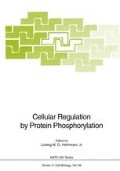Abstract
In my first lecture I presented data which showed that following mitogenic stimulation of quiescent 3T3 cells, the Mr 70 kd S6 kinase becomes activated by serine/threonine phosphorylation. From this data we deduced two facts: first, that the S6 kinase lies on a kinase cascade initiated by the activation of the tyrosine kinase of the respective growth factor-receptor (Carpenter G and Cohen S, 1990), and second, that there must be at least one other serine/threonine kinase, activated by tyrosine phosphorylation, which couples the S6 kinase with the tyrosine kinase of the receptor, an S6 kinase kinase (Ballou LM et al, 1988a). Such a model would easily fit with earlier kinetic data showing that in quiescent cells stimulated with, for example, EGF, the S6 kinase is rapidly activated, reaching a maximum between five and ten minutes and then slowly decreasing back to basal level by about 60 minutes (Novak-Hofer I and Thomas, G, 1985).
Access this chapter
Tax calculation will be finalised at checkout
Purchases are for personal use only
Preview
Unable to display preview. Download preview PDF.
References
Anderson NG, Maller JL, Tonks NK and Sturgill TW (1990) Requirement for integration of signals from two distinct phosphorylation pathways for activation of MAP kinase. Nature 343: 651–653
Ballou LM, Siegmann M and Thomas G (1988a) S6 kinase in quiescent Swiss mouse 3T3 cells is activated by phosphorylation in response to serum treatment. Proc. Natl. Acad. Sci USA 85: 7154–7158
Ballou LM, Jenö P and Thomas G (1988b) Protein phosphatase 2A inactivates the mitogen-stimulated S6 kinase from Swiss mouse 3T3 cells. J Biol Chem 263: 1188–1194
Ballou LM, Luther H and Thomas G (1991) MAP2 kinase and 70K S6 kinase lie on distinct signalling pathways. Nature 349: 348–350
Blenis J and Erikson RL (1986) Stimulation of ribosomal protein S6 kinase activity by the Rous sarcoma virus transforming protein, serum, or phorbol ester. Proc Natl Acad Sci USA 83: 1733–1737
Carpenter G and Cohen S (1990) Epidermal growth factor. J Biol Chem 265: 7709–7712
Chen RH and Blenis J (1990) Identification of Xenopus S6 protein kinase homologs (pp90rsk) in somatic cells: phosphorylation and activation during initiation of cell proliferation. Mol Cell Biol 10: 3204–3215
Gregory JS, Boulton TG, Sang B-C and Cobb MH (1989) An insulin-stimulated ribosomal protein S6 kinase from rabbit liver. J Biol Chem 264: 18397–18401
Hannun YA, Loomis CR, Merill AH and Bell RM (1986) Sphingosine inhibition of protein kinase C activity and of phorbol dibutyrate binding in vitro and in human platelets. J Biol Chem 261: 12604–12609
Kozma SC, Lane HA, Ferarri S, Luther H, Siegmann M and Thomas G (1989) A stimulated S6 kinase from rat liver: identity with the mitogen-activated S6 kinase of 3T3 cells. EMBO J 8: 4125–4132
Lane HA and Thomas G (1991) Purification and properties of mitogen-activated S6 kinase from rat liver and 3T3 cells. In Methods of Enzymol 200, in press
Meyer T, Regenass U, Fabbro D, Alteri E, Rösel J, Müller M, Ceravatti G and Matter A (1989) A derivative of staurosporine (CGP 41 251) shows selectivity for protein kinase C inhibition and in vitro anti-proliferative as well as anti-tumor activity. Int J Cancer 43: 851–856
Novak-Hofer I and Thomas G (1985) Epidermal growth factor-mediated activation of an S6 kinase in Swiss mouse 3T3 cells. J Biol Chem 260: 10314–10319
Ray LB and Sturgill TW (1987) Rapid stimulation by insulin of a serine/threonine kinase in 3T3-LI adipocytes that phosphorylates microtubule-associated protein 2 in vitro. Proc Natl Acad Sci USA 84: 1502–1506
Ray LB and Sturgill TW (1988) Insulin-stimulated microtubule-associated protein 2 kinase is phosphorylated on tyrosine and threonine in vivo. Proc Natl Acad Sci USA 85: 3753–3757
Shibanuma M, Kuroki T and Nose K (1987) Inhibition of proto-oncogene c-fos transcription by inhibitors of protein kinase C and ion transport. Eur J Biochem 164: 15–19
Sturgill TW, Ray LB, Erikson E and Mailer JL (1988) Insulin-stimulated MAP-2 kinase phosphorylates and activates ribosomal protein S6 kinase II. Nature 334: 715–718
Stabel S, Rodiguez-Pena A, Young S, Rozengurt E and Parker PJ (1987) Quantitation of protein kinase C by immunoblot-expression in different cell lines and response v to phorbol esters. J Cell Physiol 130: 111–117
Šuša M, Olivier AR, Fabbro D and Thomas G (1989) EGF induces biphasic S6 kinase activation: late phase is protein kinase C-dependent and contributes to mitogenicity. Cell 57: 817–824
Šuša M and Thomas G (1990) Identical Mr 70,000 S6 kinase is activated biphasically by epidermal growth factor: a phosphopeptide which characterizes the late phase. Proc Natl Acad Sci USA 87: 7040–7044
Sweet LJ, Alcorta DA, Jones SW, Erikson E and Erikson RL (1990) Identification of mitogen-responsive ribosomal protein S6 kinase PP90rsk, a homologue of Xenopus S6 kinase II, in chicken embryo fibroblasts. Mol Cell Biol 10: 2413–2417
Tabarini D, Heinrich J and Rosen OM (1985) Activation of S6 kinase activity in 3T3-L1 cells by insulin and phorbol ester. Proc Natl Acad Sci USA 82: 4369–4373
Tamaoki T, Nomoto H, Takahashi I, Kato Y, Morimoto M and Tomita F (1986) Staurosporin, a potent inhibitor of phospholipid/Ca++ dependent protein kinase. Biochem Biophys Res Comm 135: 397–402
Tonks NK, Charbonneau H, Diltz CD, Fischer EH and Walsh KA (1988) Demonstration that the leukocyte common antigen CD45 is a protein tyrosine phosphatase. Biochem 27: 8695–8701
Author information
Authors and Affiliations
Editor information
Editors and Affiliations
Rights and permissions
Copyright information
© 1991 Springer-Verlag Berlin Heidelberg
About this paper
Cite this paper
Thomas, G. (1991). Biphasic Activation of the S6 Kinase: Identification of Signalling Pathways. In: Heilmeyer, L.M.G. (eds) Cellular Regulation by Protein Phosphorylation. NATO ASI Series, vol 56. Springer, Berlin, Heidelberg. https://doi.org/10.1007/978-3-642-75142-4_23
Download citation
DOI: https://doi.org/10.1007/978-3-642-75142-4_23
Publisher Name: Springer, Berlin, Heidelberg
Print ISBN: 978-3-642-75144-8
Online ISBN: 978-3-642-75142-4
eBook Packages: Springer Book Archive

